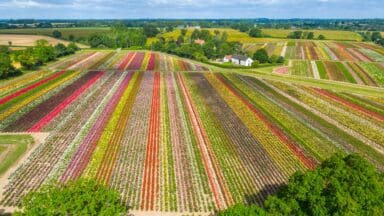
A third-generation, Whartons Garden Roses, a family-run business based in Norfolk’s Waveney Valley, cultivates over 1.5 million roses annually for the UK garden centre market. Founded in 1947 by John Wharton, the nursery is now managed by his son, Robert, and grandson, Paul.
As one of the UK’s largest growers of garden roses, Whartons employs 50 full-time, highly skilled, specialist staff. The nursery spans over 60 hectares of land at any given time, with three production sites responsible for processing the field-grown roses through grading, potting, and despatch.
Whartons Garden Roses cultivate over 300 varieties of bush, climbing, rambling, patio, and shrub roses for UK garden centres and plant retailers.
The Rose Growing Process
Bringing a rose to market requires a three-year process. With such a lengthy production cycle, growers face significant risks from adverse weather conditions and endure greater exposure to market trends and fluctuations.
Whartons has an informative video showcasing the production process which makes for interesting viewing, but in essence, the process involves the following seasons:
- Season 1: Autumn and winter land preparation
- Season 2: Early spring preparation for the planting of the rootstocks. Subsequently, in the summer the roses are grafted (budding) through the late summer, when the plants start to establish.
- Season 3: The rose crop continues to grow and flowers. In the autumn the process of lifting the roses starts for bare root and potted sales. Plants come to market at the end of season 3 and through into Season 4. Though, according to Whartons most plants are sold through the spring and summer of season 4.
- Season 4: Lifting continues through late winter. Plants are potted, right through to mid spring for container sales from February to August (or until stock runs out).
Traditionally practised in July, when the rootstocks have established and grown into bushy plants, budding is a type of grafting primarily used for roses. This technique involves inserting a small bud of the desired variety into a T-shaped cut at the base of the rootstock plant. Subsequently, the bud will grow, and the top growth of the rootstock is removed, resulting in a plant with the roots of the stock and the top growth of the desired variety. Rosa laxa is frequently utilised as the rootstock due to its resilience, low propensity for suckers, and extended lifespan.
Technological advancements have facilitated the process, but essentially rose growing remains a highly skilled, passionate, and labour-intensive endeavour. As is often the case in horticulture, it ultimately depends on sheer passion, enthusiasm, and respect for this majestic plant, which enables roses to be brought to life.
We salute and thank you.

